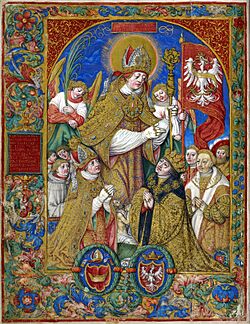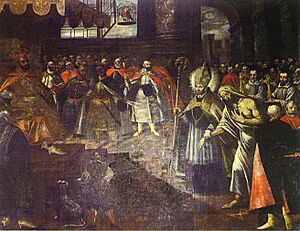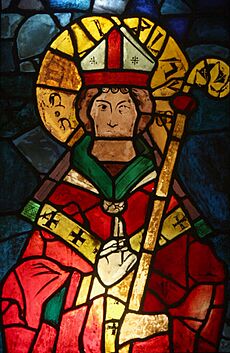Stanislaus of Szczepanów facts for kids
Quick facts for kids SaintStanislaus of Szczepanów |
|
|---|---|

Saint Stanislaus. 16th-century illustration from the Catalogus Archiepiscoporum Gnesnensium.
|
|
| Bishop and Martyr | |
| Born | 26 July 1030 Szczepanów, Kingdom of Poland |
| Died | 11 April 1079 (aged 48) Kraków, Kingdom of Poland |
| Venerated in | Roman Catholic Church |
| Canonized | 17 September 1253, Assisi, Italy by Pope Innocent IV |
| Major shrine | Wawel Cathedral |
| Feast | 11 April 7 May (Traditional Roman Catholics) 8 May (in Poland) |
| Attributes | Episcopal insignia, sword, resurrected Piotr |
| Patronage | Poland, Kraków, moral order |
Stanislaus of Szczepanów (Polish: Stanisław ze Szczepanowa; born 26 July 1030 – died 11 April 1079) was an important leader in the Polish Catholic Church. He served as the Bishop of Kraków. Sadly, he was killed by the Polish King Bolesław II the Bold. In the Catholic Church, Stanislaus is honored as Stanislaus the Martyr.
Contents
The Early Life of Stanislaus
Stanislaus, also known as Stanisław in Polish, was born in a village called Szczepanów. This village is in a region of Poland called Lesser Poland. He was the only child of a noble and religious couple, Wielisław and Bogna.
Stanislaus went to school at a cathedral in Gniezno, which was Poland's capital at the time. He might have also studied in Paris. When he returned to Poland, he became a priest. He was ordained by Lambert II Suła, who was the Bishop of Kraków.
After becoming a priest, Stanislaus worked in Kraków. He was known for his great speeches. He later became a pastor in a town near Kraków called Czembocz. He also served as a special assistant to the bishop.
Becoming Bishop of Kraków
In 1072, the Bishop of Kraków passed away. Stanislaus was chosen to take his place. He only accepted this important job after Pope Alexander II directly told him to. Stanislaus was one of the first bishops in Poland who was actually Polish. He also became an advisor to the Duke, which gave him some influence in Polish politics.
Stanislaus helped bring special representatives from the Pope, called papal legates, to Poland. He also helped to bring back an important church center, called a metropolitan see, in Gniezno. This was a very important step for Duke Bolesław to become king. Bolesław was crowned king in 1076. Stanislaus then encouraged King Bolesław to build Benedictine monasteries. These monasteries helped spread Christianity in Poland.
The Legend of Piotr
Stanislaus had a disagreement with King Bolesław about some land. Stanislaus had bought land for the church near the Vistula River from a man named Piotr. But after Piotr died, his family claimed the land belonged to them. The King sided with Piotr's family.
According to a famous story, Stanislaus brought Piotr back to life! This was so Piotr could tell everyone that he had indeed sold the land to the bishop.
An old story says that Stanislaus asked the King for three days to find his witness, Piotr. The King and his court laughed at this strange request. But the King gave Stanislaus the three days. Stanislaus prayed without stopping. Then, dressed in his bishop's clothes, he went with a group of people to the cemetery. Piotr had been buried there three years earlier. They dug up Piotr's grave until they found his remains. Then, in front of many people, Stanislaus told Piotr to rise, and Piotr did!
Piotr was given a cloak and brought before King Bolesław. He spoke for Stanislaus. The court was amazed. Piotr told his three sons off and said that Stanislaus had truly paid for the land. The King had no choice but to drop the case against the bishop. Stanislaus asked Piotr if he wanted to stay alive, but Piotr said no. So, Piotr was laid back in his grave and buried again.
Conflict with King Bolesław
A bigger problem happened between Stanislaus and King Bolesław after a long war. Soldiers were tired and went home because they heard that their land and wives were being taken.
Whatever the real reason for their conflict, Bishop Stanislaus decided to excommunicate King Bolesław. This meant that Bolesław was no longer allowed to take part in church services. This action helped the King's enemies. The King then accused Bishop Stanislaus of being a traitor, and the royal court found him guilty.
The Martyrdom of Stanislaus
King Bolesław sent his men to kill Bishop Stanislaus. But they were afraid to touch the bishop. So, the King decided to kill the bishop himself. It is said that he killed Stanislaus while the bishop was celebrating Mass. Some say this happened outside the walls of Kraków at a place called Skałka. Others say it happened inside Wawel Castle.
The exact date of Stanislaus's death is not fully known. Some say it was April 11, and others say May 8, 1079.
This murder made people across the land very angry. It led to King Bolesław II the Generous losing his throne. He had to escape to Hungary. His brother, Władysław I Herman, became the new ruler.
Whether Stanislaus was a traitor or a hero is still a debated question in Polish history. His story is similar to the murder of Thomas Becket in England in 1170. Thomas Becket was killed by men working for England's King Henry II.
Becoming a Saint
People began to honor Saint Stanislaus right after he died. In 1245, his holy remains, called relics, were moved to Wawel Cathedral in Kraków. In the early 1200s, Bishop Iwo Odrowąż started the process for Stanislaus to become a saint. He asked a writer named Wincenty of Kielce to write the story of Stanislaus's life. Stanislaus of Kraków was officially made a saint by Pope Innocent IV in Assisi, Italy, in 1253.
His feast day (a special day to remember him) was set for May 7. However, Kraków celebrates it on May 8, which is thought to be the day he died. This has been done since May 8, 1254. In 1969, the Church changed the feast day to April 11. This is now considered the actual date of his death in 1079.
As the first Polish saint, Stanislaus is a special protector of Poland and Kraków. He shares this role with Saint Adalbert of Prague, Florian, and Our Lady the Queen of Poland.
Wawel Cathedral, where Stanislaus's relics are kept, became a very important national church. Almost all Polish kings, starting with Władysław I the Elbow-high, were crowned while kneeling before his coffin. This coffin stands in the middle of the cathedral. In the 1600s, King Władysław IV Vasa ordered a beautiful silver coffin for the saint's relics. It was destroyed by Swedish soldiers during a war, but a new one was made around 1670.
Honoring Saint Stanislaus has been very important for Polish patriotism. During a time when Poland was divided into many small parts, people believed that Poland would become whole again, just like the pieces of his body were brought back together. Many years later, when Poland was being divided again by other countries, the people who wrote the Polish Constitution of 3 May 1791 dedicated this important document to Saint Stanislaus. His feast day was close to the day the Constitution was adopted.
Every year, on the first Sunday after May 8, a procession takes place. It is led by the Bishop of Kraków and goes from Wawel to the Church on the Rock. This procession, which used to be a local event, became very popular in the 1900s. This was thanks to Polish church leaders like Stefan Wyszyński and Archbishop of Kraków, Karol Wojtyła. Wojtyla, who later became Pope John Paul II, called Saint Stanislaus the protector of moral order. He wanted his first visit back to Poland as Pope to be in April 1979. This would have been exactly 900 years after Stanislaus's death. However, the government at that time stopped the visit, so it happened in June instead.
Many Catholic churches for Polish communities outside Poland are named after Saint Stanislaus.
In art, Saint Stanislaus is usually shown as a bishop holding a sword. The sword represents how he died. Sometimes, he is also shown with Piotr rising from the dead at his feet.
Feast Days
- 25 January – This day remembers when his relics were moved to the Church of Saint Roch.
- 11 April – This day remembers the anniversary of his death.
- 7 May – This day is celebrated by Traditional Roman Catholics.
- 8 May – This is the main day of celebration in Poland.
- 27 September – This day remembers when his relics were moved from Skałka to Wawel.
- 6 October – This day remembers when his relics were moved to Esztergom.
Images for kids
See Also
- Gaude Mater Polonia
- Archbishop of Kraków
- Order of Saint Stanislaus
- Saint Stanislaus of Szczepanów, patron saint archive








